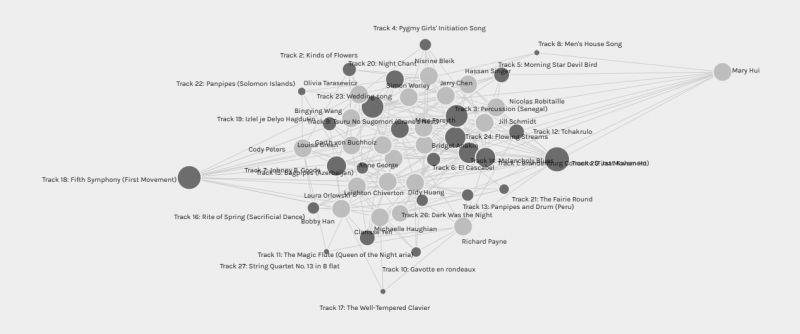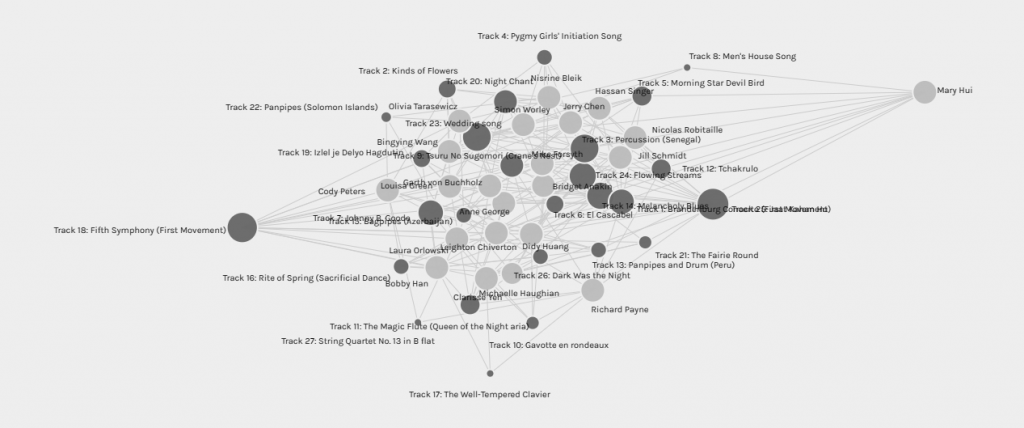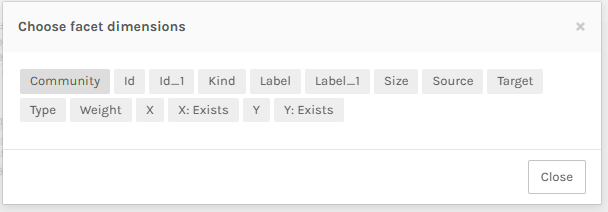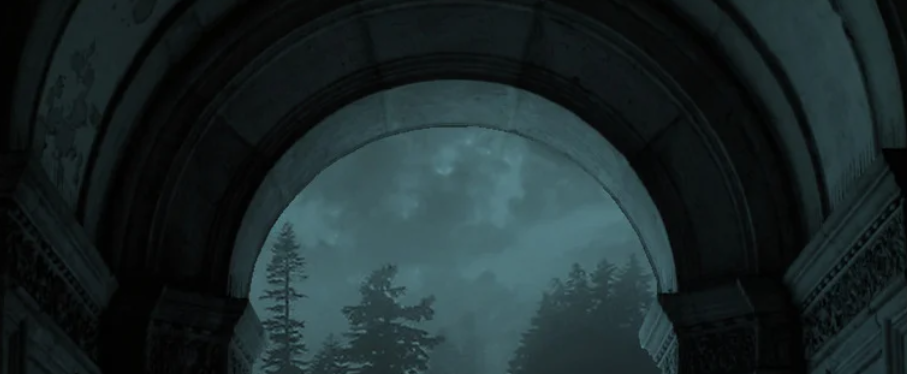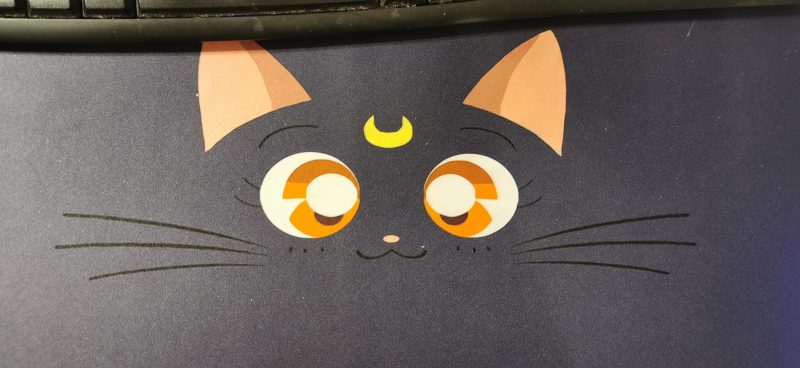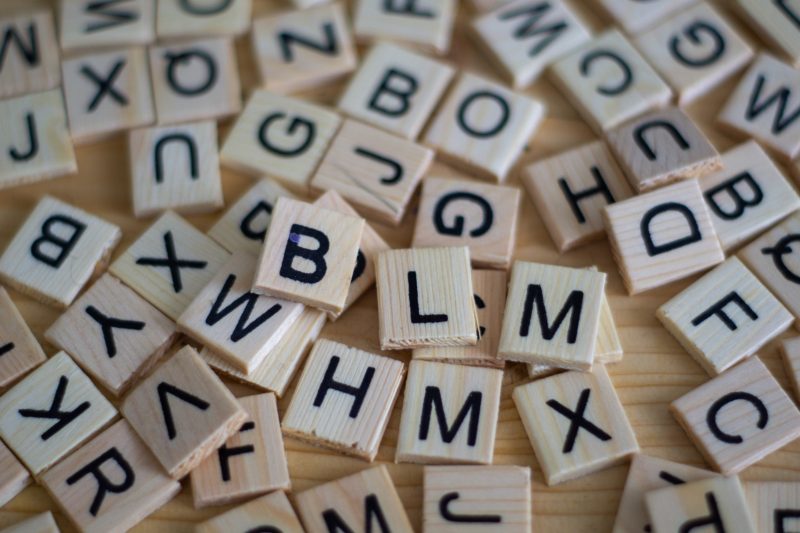Please find my final assignment in Google Docs
Task 12: Speculative Futures
StandardThis week, I had a great opportunity to play the game Situation Lab’s Thing from the Future. At first, I didn’t understand what I had to do and was flipping through the cards using the generator. Then I realized, the excel generator combined the cards together and it was less complicated. (oops!) Now I learned something new 🙂
The first scenario generated for me was the following:
“Describe or narrate a scenario about a candy found two generations into a future in which a profound historical evolution has occurred. Your description should address issues related to algorithms and elicit feelings of dread.”
To match the gamification nature of this week’s exercise, I created a short interactive game and tried to connect it to the readings we had this week. Enjoy!
As I create and implement the changes to this game according to this story, it made me think of ChatGPT and how slow I am at creating an artifact compared to them. I enjoyed Dr. Shannon Vallor’s talk immensely and I find that I agree with almost everything she mentioned. One quote that stuck with me was that “AI was still not ready for solo flight” (Vallor, 2018) and it is up to us, as humans as a collective to ensure that it is used for the greater good that can enhance the human race rather than hinder it.
This reminds me of an article I recently read where Bill Gates suggest that “AI could lead to 3-day work week” (Murphy, 2023) because it can help us “cook and stuff”. Now this might scare people into thinking that it is another step to eliminating jobs. As we look around, it is true. Self-check outs are slowly replacing humans cashiers and in countries like Japan, there are stores that are entirely run by robots. However, Microsoft’s co-founder suggests that the “purpose of life is not just to do jobs, AI could provide major benefits to productivity, health care and education” (Murphy, 2023). This can sound optimistic for the average family who wishes to spend more time with their kids. It can potentially eliminate scenarios in Tommy Orange’s story where the child believes that adults “hates children” (Ford, 2020) and adults only puts up with them until they can drop them off at school, escape and focus on work.
This is slowly becoming a reality. 5 years have passed since Dr. Vallor’s talk, and while it is still true that AI is still not at a stage for full autonomy, (i.e.: In Greenspan’s example, there are no self-driving vehicles launched to the public in America yet to prevent potential accidents like the uber self-driving vehicle.) I can see companies such as Microsoft using the data and/or educational material that we publish / hosted on their servers to enhance their AI to create curriculum at record speed. Like Mitrovic, I can “speculate” that AI can “open up all sorts of possibilities that can be discussed, debated, and used to collectively define a preferable future”(Mitrović, 2021) for a new generation of tech savvy learners. Perhaps a new classroom setting where learners can learn wherever and whenever in person or online and the traditional classroom will evolve into something that is entirely new.
Jobs still won’t be eliminated, but we humans will adapt and change our roles in society based on what is built by the elites. Mitrović et al. made a great point about speculative design and instead of being scared of it, we can embrace the future to see how it can be used to enhance human lives.
There are a lot of positive ideas being proposed, but for some reason, there is still a feeling of unease and dread when I look at this. There are a lot of promise from the higher ranking business men and women in society, but will it really enhance people’s lives, or will the thoughts of greed result in AI only benefiting the select few who are privileged enough to experience the rewards?
There’s still a lot of room to explore in the realm of AI and I am not brave enough to see the end result.
References:
Ford, A. C. (Host). (2020, September 2). Tommy Orange: Reopening. [Audio podcast episode]. In The Chronicles of Now. Pushkin Industries.
Santa Clara University. (2018, November 6). Lessons from the AI Mirror Shannon Vallor [Video]. YouTube.
Protected: Task 11: Detain/Release or Text-to-Image
StandardTask 9 : Network Assignment Using Golden Network
StandardThis week’s assignment is quite interesting. Along with my classmates, we were tasked with choosing 10 songs out of 27, and then analyzing the data to see if we can spot any trends / reasons behind why we chose the songs we did.
This is what was generated when I uploaded the data into Palladio.:
I pulled my name out to see if it’s the same size as my classmates, and it seems like it is similar. I guess it is because everyone in class chose 10 songs? Oh I found out 1 person only chose 9 songs… does that skew the data?
The smaller circles are songs that were not chosen as often as the bigger / darker circles. At this point, I have no idea why people chose the songs they did, but I know which songs are more popular than the other. To be fair, I went into some of the blogs to find out why people chose their songs. Some of them simply like the beat of the music / songs. Others chose the songs because they like the instrumental range it included. I did find some of my colleagues disliked some of the songs. However, even when I toggle the filter, it was difficult to determine the rationale of the decisions based on this visualization alone.
So I went to Edit dimensions to see and sort by frequency. Seems like Track 25 is the most frequently picked and track 17 and 27 was the least picked.
I went back to Youtube to play the songs again just to see if I can find a common trend. I still cannot find out why, so I then came back to Palladio. Then I found out who picked which song by playing around with the settings, and played with the calculator function inside Palladio.
Yet, I was still confused as the labels were not descriptive. For example, I have no idea why I was filtering what I was filtering. I can choose the source and target. Depending on what I choose, the visualization changes. This is an interesting view, but what do the numbers mean? I don’t really understand what is being displayed here.
Another reason for the confusion is that I don’t understand what the dimensions are. The program asks me to choose a dimension, but what do they mean? It seems like Label_1 consist of all the tracks, and community consist of the number of students. Source is who picked what… X/Y related ones are how the the nodes are plotted, so it doesn’t really help me find out why people chose the songs they did. Perhaps if there was facet with categories for reason and students were able to select why they chose the songs, that may be more helpful.
i.e.: Reason: Genre, upbeat, liked the song, disliked the song, etc.
At this point, it seems like the data displays quantitative results rather than qualitative even though the plots are visualized, it does not provide any rationale to why people chose the songs they did without going to each blog to see task 8. This defeats the point having a centralized statistical data hub to depict the reason for why people chose the songs they did.
Task 8: Golden Record Curation Assignment
StandardIf I were to weave my own story and select 10 songs from the Nasa’s Golden Record list, it would probably look like this:
14. Melancholy Blues – The type of music and how it is recorded provides a glimpse to the audience that life haven’t always been this advanced, and humans evolved from recording songs using limited to very advanced technology. It also speaks to the history itself… it hasn’t always been happy.
21. Fairie Round – While history haven’t always been great and humans make a lot of selfish decisions that impacts evolution, there are also good times and those moments should be celebrated.
24. Flowing Streams – Speaks to the many innovations that sparked from this country. The paper for example was made by using streams of water and pulp from bamboo and wood. innovation does not have to be loud, but it can impact the world in a great way.
- Brandenburg Concerto (First Movement) – I adore classical music and many of which originated from / inspired by European countries. This also includes a variety of string instruments that follows the same sheet music, which is quite unique.
3: Percussion (Senegal) – On the opposite end, this one includes percussions that follows along with the same sheet music to create music that people are able to get up and dance to!
8: Men’s House Song – I wish to include this as controversial as the title may be, but the world is still a men’s world. While there is an effort to strive for equality in all senses, there is still a lot of room to explore.
23: Wedding song – While this song is about a woman not wanting to get married, there are still a lot of people wanting to find true love. In the past, marriage may be created as a trade / monetary reasons, this technology has now evolved into something very different. People can choose their partners and choose to stay with them forever because of love. This song shows that marriage is evolving and men and women can learn to depend on each other for more than just financial reasons.
5: Morning Star & Devil Bird – Again, not everything is positive in this world. Just wanted to show a contrast to the happy times, there are still wars ongoing. What seems to be the truth on 1 end… may not be in the other side.
12: Tchakrulo – Going back to the point where people depend on each other. I chose a song sang by the choir to illustrate the point that together as a species we can still make beautiful music if given the chance.
Track 13: Panpipes and Drum (Peru) – Chose this song because it has the style as the first song, but it is heavier on the percussion side. It represents that we can somehow made our own history with our current technology, and whoever is listening to this track, hopefully they will be able to listen to what is here and build upon / innovate to this list of music.
Linking Assignment
StandardBefore I start, I just wanted to appreciate the opportunity to take ETEC 540. This is one of the final courses I have to take for my MET program and what a memorable experience this has been. While I had moments of confusion, I also had many moments of clarity as I progressed through the course.
I do not take this opportunity for granted.
Focusing on the actual task at hand, I am tasked to choose 6 items from on 6 different blogs (from my classmates) and create links and connections to the class readings, my own understanding of the material, and my peers’ interpretation of the course material.
1) Introductory week
In all the courses I’ve taken in the MET program so far, I’ve always enjoyed participating in introductory week because I enjoy reading everyone’s background and learning from their experience. I also share everyone’s excitement about a new start of a semester and everyone is happy to contribute.
Connection: Louisa Green
Louisa Green decided to create her first task using Prezi and the post was hosted using Wix. In contrast, I created my first assignment using WordPress and used an existing template with a left navigation. My classmates can easily find all my posts that way.
At first I thought her assignment was a video, but it actually had interactive buttons for people to navigate. Like me, she had multiple bags. However, instead of focusing on only 1 bag, Louisa was able to include all three and had a very interesting way to present all 3 to her audience. In terms of co-authoring, I’m not sure if Prezi has a feature that allows people to comment or to provide feedback. I also do not see a feature for commenting in the task page. With that in mind, I really appreciate the interactivity of Louisa’s work, because she was able to include interactivity and I only included static images and text to create my introduction.
I also liked the fact that you can “dig deep” into finding more about Louisa using the interactive buttons. For example, I clicked on the black bag and it listed out a list of items, then she had a second navigation where when clicked, I could find out more information about her. The “digging” gesture is very similar to the motion we use in real life when we “dig” through our bags to find out what we want. In this case, I can find out more about Louisa.
In comparison, my own webspace has a comment section where users can interact and provide their thoughts and feedback. What my site lacks in interactivity, it makes up in ease of access to content. Users don’t have to scroll back and forth in order to find their information. In addition, I like having bigger text so that people can read without having to squint or afford an additional click in order to view my post in full screen / to
2) Does language shape the way we think?
I really enjoyed this week’s reading because it focused on how language is a technology. No matter if it is words, sounds, dance, etc., it will keep evolving with every generation. For this week, I chose Garth’s post to focus on because while I lived in Canada for quite a long time, my main language is English. It is interesting to see another person whose primary language is also English and see what their experience is like after listening to Dr. Lera Borditsky’s lecture.
Connection: Garth
In terms of the content of the post, the difference between our posts is that I focused mainly on the readings of the week and made connections to how the 3 videos can relate to each other. I noticed that Garth referenced to a book called the Power of Language. He began by focusing on his own experience and then slowly moving towards technology. Garth and I also wondered how language can shape thinking. Dr. Boroditsky mentioned that the 2 ways in which language can be used to change our thinking is to “Train new ways of talking” and “To take language away”. I appreciate that Garth included real life examples such as topics about abortions and using the term “pro life” or “pro choice” and how it can be used as a tool for social engineering, whether it can be used in a positive / negative context.
Similarly, I used dance as a way to “train new ways of talking” as stories can be spoken through dance and movements of the body, rather than just words. New performers can take a style or a portion of a dance piece and evolve it in another piece to create a story that can create positive / negative impact on the audience.
We also agreed about technologies / social media as the new way of communication and how we can include images / videos, etc. as new languages to communicate (whether it is grammatically correct or not). It is also a natural occurrence as each new generation arise. Instead of using just text or hand drawings, humans has evolved communicating through text and instant messengers like whatsapp. I included 21 century “innovative” apps like Steezy, Tiktok and other social media platforms to create and share dances, tutorials and other facts through videos with their peers and colleagues.
Technologies and Platform
Both Garth and I used WordPress. He included a reference to the Power of Language, which people can easily access if they wish to explore the reading further. He included social media buttons so people can like or tweet his post if they wish to share it. Both of us included a comment section so people can include their feedback and thoughts.
Constraints and Pedagogical Underpinnings
Garth included a very good point about people who live in multiple places around the world score better on tests of creativity. He also included how a lot of the greatest authors are non-native English speakers and stresses that multilingualism is important in educational practices. It reminds me of the Shetlandic poet, Christine de Luc and how she was able to easily switch dialects from Shetlandic to English while she casually continue to read her poem. Perhaps being able to grow up or explore multiple environments shapes the way one thinks and interpret languages. The unique experience can, as Dr. Borditsky mentions, “train people to talk in new ways”.
4) Manual Scripts
For my third link, I decided to focus on week 4’s manual script assignment. I learned about the evolution of word and how it was passed down from generation to generation. It was interesting to see how paper was invented and how it was initially used to document laws and policies. Eventually it evolved into papyrus paper and every day people can use it to invent stories and to create artwork. Now we have have evolved using digital canvases such as WordPress where anyone can freely type their thoughts down and conduct business with a click of a button. I chose to compare and contrast my task with Nick Robitaille‘s post as we both did a manual script rather than create a potato stamp for our assignment.
Connection : Nick Robitaille
For this exercise, both Nick and I had no trouble transferring our stories about our newly developed hobbies into written words on paper. However, we both found the processes physically demanding as we are both accustomed to producing languages using texting or typing. Both of us shared that we used paper to drop down notes or lists using sticky notes / note books / whiteboards, etc. but we would use technologies such as word count, spell check and other every day tasks using phones and computers. We also mentioned about spell check , word count and grammar check and how these are what we take for granted.
I was surprised that while our experience was quite similar, Nick only had 2 pages of text, where I had 8 pages of text. It doesn’t seem like my writing was much bigger than his, but he was able to save a lot of space and saved some trees! In terms of tidiness, I agree that the mechanical version provides the backspace button which eliminates the labour of having to cross out errors and grammar mistakes or difference in interpretation.
In my post, I also included the idea of security. During the pandemic, a lot of people used the pen-to-paper method to store their private information if they do not wish to share it with the rest of the world. Indeed, everything we type / say inside a web browser can be tracked and distributed as data. It is something I try to intentionally tell myself to avoid any cyber security related incidences.
Technologies and Platform
Both Nick and I used WordPress to document our process. Both of us included a comment section so people can include their feedback and thoughts. I’m not sure if there are any constraints to the course, in fact, this will be a great artifact to share with others (aliens?!?!) and how we as a species have evolved / what we do in our everyday lives before artificial intelligence (AI) become our supreme overlords.
Constraints and Pedagogical Underpinnings
Nick and I in our post both hinted that we have come a long way from using paper to record lists of laws to now being in the digital age where we can freely create our own worlds (i.e.: create stories to distribute to peers in seconds vs taking weeks to send a letter via carrier pigeon).
7) Mode Bending
Task 7 was tough because it was very hard to recreate Task 1 using just audio alone. However, Olivia Tarasewicz found a very funny way to “dig deep” into finding her bag. Both of us took a completely different approach but had similar thoughts while completing the assignment. That is, text is not just a written language and can be depicted using music, dance, poetry, etc.
Connection : Olivia Tarasewicz
Olivia was able to achieve what she wanted to convey by creating a detective story that took the focus off her as a central character, to someone who is not able to provide their side of the story. By including action and suspense into the narrative, I found myself being drawn to the story right away and wanted to find out more right away. Both of us took time to think of what is the right approach in handling this. While there is no right or wrong way, I believe both of us were able to conclude that while language can be depicted using sounds, it is hard to describe individual or specific people, place, or thing without using text.
For my project, I focused on language as music and that a simple piece of music can remixed overtime, but the base sheet music is the same. I also stressed that it is important to keep our history as accurate as possible as each generation can learn from the next.
Technologies and Platform
Both Olivia and I used WordPress to document our process. Both of us included a comment section so people can include their feedback and thoughts.
Constraints and Pedagogical Underpinnings
As previously stated, it was very hard to describe the process using only audio. If I had to do it again, perhaps I would get rid of the robot voice and just include the 3 songs to see if the audience is able to capture the 3 different sounds which stems from the same sheet music.
9) Network Assignment Using Golden Network
In week 8, the class was tasked to choose 10 songs out of 27 so we can create a set of data to interpret. Then in week 9, we upload this data into Palladio and was tasked to see if we can see the reason why people chose the songs they did. Upon reading Jerry Chen‘s blog post, I found that we had similar findings, but both Jerry and I had different methods of achieving the same conclusion.
Connection : Jerry Chen
Both Jerry and I were able to find the “Top voted song” using the facet dimensions tool. Jerry took it one step further to sort by “communities” and how 6 groups of people chose the same songs. He also found that the top 10 songs had “at least 45% of class votes”. In the section called “Familiarity” he was able to identify the 2 most popular music genres to speculate that perhaps the reason why people chose the songs could be because the popularity of the music styles of the popularity of the artists.
I chose another direction and found out the two “least voted songs” (they were tied). My rationale was to compare and contrast the 2 songs to see whether they had significant different in beat, sounds, genre, etc. I went to each blog to see why people chose what they did. Then I played around with the different categories. Similar to a pivot table in excel, I played around with each category to see if any of them makes sense.
However, even though both Jerry and I used very different approaches, we both found the rationale inconclusive by viewing plots and visual data alone.
Technologies and Platform
Both Jerry and I used WordPress to document our process. Both of us included a comment section so people can include their feedback and thoughts. If there was a way to pull the rationale section from each of our blogs, perhaps there is a plugin in WordPress that can do this and we can all plug in the rationale of why we chose the songs (list from drop down), that may be interesting.
Constraints and Pedagogical Underpinnings
Jerry and I both hinted that while there are facets that represented geographical locations, our classmates did not choose the songs based on where it was originally composed. Perhaps more research is needed in order to reach our conclusion.
12) Speculative Futures
Task 12 was a lot of fun. We were tasked to play a game then create our own stories and narratives based on what was generated from AI. I was so impressed with Bridget Anakin’s task because she create a short story and poem based on her given scenario! I was really excited to read it and to see if there are any similarities / differences to mine 🙂
Connection: Bridget Anakin
I was immediately immersed into the story that was created by Bridget. The images she chose for the cover was also fitting since. Seems like the tone and the setting of her story was quite dark. I really enjoyed her writing, and wished I was able to create short story as exciting and engaging as the one composed. I believe the generator created a completely different story for mine, because I created a short escape game using Genially about candies and how it was found after 2 generations. I was able to include images that matched the 2 different eras.
Both of us were able to hint at “speculative” design into our short stories. The quote I included from Mitrović is quite similar to the tone of her story.:
AI can “open up all sorts of possibilities that can be discussed, debated, and used to collectively define a preferable future.” (Mitrović, 2021).
She was able to capture the darker side, while I was able to capture the more hopeful side of the future when AI takes over.
Technologies and Platform
I continued to use WordPress to document my process and was able to embed the game created using Genial.ly into my post. The borders look a bit funny after embedding, so I included a link on top of it so people can also play in full screen mode. Bridget was able to embed her story into Google Sheets and it looks like she created the story using Canva. The navigation was a bit tricky as I find myself confused clicking back and forth between pages without any arrow keys. I was able to scroll up and down, but the 2 scroll bars created a bit of confusion. I was able to find the full screen mode after clicking on the blue link underneath.
Constraints and Pedagogical Underpinnings
An assignment based on an existing game is a great idea. I really enjoyed playing it and coming up with the narratives while incorporating my own ideas into it. It would be interesting to see if we can incorporate AI somehow, similar to week 3’s assignment. Instead, we use ChatGPT to create a narrative based on the scenario and observe how fast it is able to generate it. It is still a scary thought that AI will eventually shape our environments into something that is unrecognizable. However, I am still hopeful that there are still good that can enhance human life. If that is allowed.
Task 7: Mode-bending
AudioWow, what a change this week. I don’t have much experience with audio design so it was quite challenging! In fact, I already used a pretty high quality microphone. However, it was a great experience to put The New London Groups ideologies into action and see what can be produced.
Have a listen and let me know what you think!
Transcript:
Hello and welcome to my “What’s in my bag assignment”, version 2. After I finished reading the paper written by The New London Group, I was fascinated by the idea that we as people live in vibrant and multi-layered life worlds. These realms of social activities are labelled as work life, public life, and private life. Each of these layers can interlace with each other. In the educational context, educators have to adapt to these “3 major realms of social activities” of the learners. While we try to discipline and transfer skills and knowledge in a traditional way, we must also adapt an inclusive and multimodal approach as technologies continue to advance.
For this version of “What’s in my bag”, I wish to focus on 3 distinct audio designs of the same music piece called Azalea Town. It is written as a background music piece of a Pokemon game I played during childhood. Please enjoy and tell me what you think.
So, what do you think? The reason why I chose this sound, rather than having sound effects of each item that is in my bag, is because it depicts my childhood and the culture I surround myself in. There is a 10 year age difference in each of the sound clips so it represents 3 of my life worlds. Each song is released in a game that has 2 versions which represents my dual-nationalities.
In terms of the music, the first has a traditional 8-bit style in the Gold and silver game produced in 1999. It is played in a MIDI format when technology is not as developed. This represents the mechanical things I have such as keys, tissues, masks, etc. that can be used in my work lif.
The second clip is a remixed version of Heart Gold and Silver produced in 2010. The technology used in this is more modern, so the sound design is smooth and easy to listen to. This represents the laptop, mouse, charger, that I can use to develop my public persona.
The third clip is a jazz rendition of the same sound clip produced in 2023, close to the end of the pandemic. After the pandemic, most people wish to meet in person and do fun things together. The Crochet set depicts this as I like creating fun projects with people of any culture and demographics.
Even though the style of the song evolves as each year passes, the melodies and the written music are the same. Similarly as each student evolve into a new version of themselves each year, they still carry their own histories and biological make up. We as educators should adapt and design new ways of teaching while keeping the traditional content historically accurate.
Task 4 : Manual Scripts and Potato Printing
StandardThis week, I am tasked with writing a journal entry (500 words) by hand / manual production. To be honest, this was quite a therapeutic experience for me since I grew up learning using the paper and pencil method. This is the results of this experience:
I enjoyed this exercise quite a lot, especially when I had the chance to do this on my sailor moon mouse pad 🙂 It reminds me of my childhood where I would write book reports and then add stickers to decorate my creation. In fact, I still have a photo of this!
- Do you normally write by hand or type? Did you find this task difficult or easy? Explain.
I am a hybrid hand / type communicator so I found this task to be quite nostalgic. It was easy visiting my childhood to remember the good times of doing everything by hand. However, I’m also fully adapted to technology and even have my bachelors degree in Interactive Arts and Technology. I missed knowing the word count right away without having to manually count it on paper. I enjoyed the backspace button which is neat and tidy compared with me crossing out certain words when I made an error.
- What did you do when you made a mistake or wanted to change your writing? How did you edit your work? Did your choice of media play a part in how you edited your work?I crossed out my mistake. I appreciate the codex of modern technology where words that are incorrectly spelled are underlined in red. They can also be easily copied and or erased. In fact, rather than having to compose a series of text, words can now be suggested to you by AI such as ChatGPT. Humans have evolved greatly from struggling with documenting laws / tasks on scrolls and delicate Egyptian papyrus paper to parchment paper to digital canvases. What an incredible evolution of history.
- What do you feel is the most significant difference between writing by hand and using mechanized forms of writing? Which do you prefer and why?Readability, Replication and distribution. With the technological development of paper and the printing press, the “availability of paper encouraged a highly literate community with regular postal services, delivering correspondences as far away as India.” (Lamb et al., 2020). However, with the digital platform and web 2.0, text can be generated, replicated and distributed worldwide with a click of a button.I prefer using the pen-to-paper method for ideas that are private because you never really know who is on the other side of the screen and what they can do with the information. However, outside the realm of cyber security, I prefer the digital method as a form of writing down ideas that I can freely share to my peers and to the community because it is enjoyable to me and I can find peers with similar interests faster with this method.
References
Lamb, R., & McCormick, J. (Hosts). (2020, May 26). From the vault: Invention of the book, part 1. [Audio podcast episode]. In Stuff to blow your mind. iHeart Radio.
Lamb, R., & McCormick, J. (Hosts). (2020, May 28). From the vault: Invention of the book, part 2. [Audio podcast episode]. In Stuff to blow your mind. iHeart Radio.
Task 3 : Voice to Text Task
StandardThis week I am tasked to create a story using text to speech. In 5 minutes, I thought up a story and spoke to it like I am talking with a friend. Below is the story:
Why did I decide to play drums instead of other melodic instruments I grew up actually learning how to play piano my mom really loved the piano and really wanted me to play it I got to level seven of piano and I actually really enjoyed playing piano but I for some reason even after practicing for a long time I just never got to the level where the other kids were and I think my mom was very concerned about oh you know Mary might not be able to pass this very well you know she might not understand the note notation very well and it’s true and notes were very hard for me to read I tried to memorize the you know notations to you know timing and everything like that but it took me longer to learn than other kids so I’m with the limited amount of financial backup that our family have we decided to stop after we hired one of the private teachers for a very last day I remember very you know clearly my mom was like you know Mary I can’t afford you know providing you a teacher anymore for private piano lessons so do you still want to do this if not we’re going to cancel this and I just thought you know if Financial is really a thing you know that hinders me to progress I’d rather not waste my mom’s money maybe I could put it into other things so I decided to quit piano moving forward I was also involved with a lot of you know a community activities and you know I hung out with kids who are really good at piano really good at guitar good at base but there was never like a solid drummer that was available and so I’m like wow you know this might be an Avenue that I can perhaps fit in that I can help out with if I cannot understand the notation of piano maybe I can work with drums and so I decided to take lessons drumming lessons and my goodness I thought it was so fun like I picked up the sticks and the rest were history I think I just fell in love with the instrument my mom bought me an acoustic set I just would not stop playing even though the neighbors kept complaining I just really enjoyed you know just playing along with music being able to provide the beats and the rudiments to back up everyone the other reason why I enjoyed it is because I’m not much of a singer so I you know I can speak music through through beats and and Rhythm and I don’t have to talk and be insecure about my speech impairment and that a lot of people notice whenever they start talking to me to my mother’s dismay I never ended up continuing with piano and she but she was very supportive of of me playing drums i you know even though it was challenging for a while even though I can pick up the Beats of the song and just by listening to it they were a lot of little things that caused issues when I was playing with the band and you know I found out they were actual rudiments and notation that I had to learn throughout my time learning with the teacher and over time you know throughout my teen years I grasped the concepts and I was able to apply it and it was a much smoother time than you know learning through YouTube or you know or other like virtual software rather than here by my side and coaching me and picking up any errors that I do yeah it was very good and this is why I started playing drums
2. identify and analyze what you got, using the following questions as a guide:
- How does the text deviate from conventions of written English?
The text that was generated by Ai lacked punctuation and grammar. For example, after a few sentences, a new paragraph should be formed. However, the text generator just kept listening and then generating text as it came out. I find that spoken language is quite different from written language. Written language is often more formal and there is no slang included.
- What is “wrong” in the text? What is “right”?
The AI correctly capture and generate text based on what I spoke. However, I had to manually add in punctuation afterwards. There may be a feature that does this… or perhaps I have to verbally tell them create paragraphs, for example.
- What are the most common “mistakes” in the text and why do you consider them “mistakes”?
That is an interesting question, I automatically thought it was a mistake because I assumed that the text generator would auto generate sentences, or re-arrange words to create sentences. However, if I do not verbally tell them to do so, is it really a mistake?
- What if you had “scripted” the story? What difference might that have made?
I would have more time to plan and organize my thoughts. I felt like what I spoke was all over the place. Half way through I lost track of where my story was going so I began to fill in more information that may/may not be relevant to the story
- In what ways does oral storytelling differ from written storytelling?
Oral storytelling can be more casual, and no one really notices poor grammar unless the sentence structure is not proper.
The sentence structure of a written storytelling can be more polished since the author will have more time to plan.
Task 2 : Does language shape the way we think?
StandardThis week, I am tasked with watching Dr. Lera Borditsky’s SAR lecture from May 2017 and write a few thoughts of what spoke to me.
The statements that spoke to me or I can relate to at a personal level are:
- [1:16] Introduction to the topic on how languages we speak, shape the ways we think. We can use a finite set a rules that we combine… creating air vibrations… implanting into your brain and turning them into language”
- [5:35] Dr. Boroditsky speaks to the Navajo verb chart – It is interesting to see how a simple word, “consumption” can be broken down into so many parts and be used in so many ways
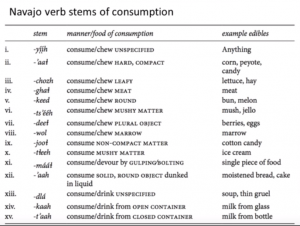
language breakdown
- [11:01] Dr. Boroditsky mentions about how we think about time, place, colour, etc. People reading from left to right, but languages such as Arabic that people read from right to left, can have VERY different meanings.
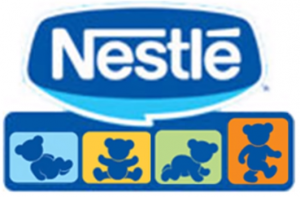
Nestle commercial can have a very different meaning reading from right to left, rather than left to right.
In addition, other languages depicts future as behind, rather than in front. Other cultures don’t use languages relative to the body, but rather, directions in a map (North, South, East, West).
- [21:07]When you teach people to talk in a new way, you are teaching them to think in a new way as well.
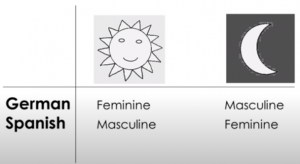
Language creates categories
- [21:05] Language creates categories. If you learn a language that depicts the sun / moon to be masculine or feminine, would you start to think of the sun / moon to be more male like or female like?
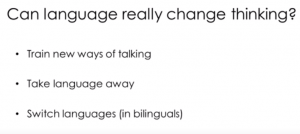
- [43:47] While languages and cultures make us smart (through thousands of years), it reduces cognitive entropy… Meaning, we can think about the world in many ways, but we don’t the thinking the same way.The languages are ever changing, and evolving.
Introduction
Dr. Lera Boroditsky spoke to how our brain interprets language. Person A can form new meaning using verbal slurs, sounds, and vibrations which when Person B hears it, their brains can form new neurons to gather information and forms new meaning. The difference of interpretation depends greatly on the listener’s culture and what is their mother tongue. A great example of this is when Dr. Borditsky displays the Nestle commercial where people who reads left to right can interpret the ad very differently than a person who reads from right to left. This can cause misunderstandings even if the speaker means well.
Language as Technology
As a dancer at one point in my life, I can relate to McDonald’s perspective that “dance is a relic, a living tradition… past down from generations to generations”. Language does not have to be spoken, it can be depicted as dance, movements, songs, or any type of art. When another artist mimics the dance teacher, “they’re not just repeating movements” they are putting their own “stories” into the dance movements. Their own cultures and interpretations as they build on it. As Dr. Boroditsky suggests, language is ever evolving. Technologies, such as Steezy and social media platforms, such as Instagram, Youtube and TikTok provides a network of opportunities for dancers, artist and other content creators to freely expand on their own language and pass it down to the next generation worldwide.
Dialect VS Languages
Watching the next video…It was bizzare… Actually, I did not even realize when Shetlandic poet, Christine de Luca softly read in English and then subtley switches into Shetlandic. Perhaps I was still adapting to what she was speaking to and then suddenly, I could not understand her anymore. I kept going back to a point where she switches, but still felt very strange. It rings true, as Dr. Boroditsky suggests, that languages are interpreted as sounds, and vibrations. Sometimes if we don’t pay enough attention, there may be misinterpretations or we may miss important changes in dialects. How do we as language speakers eliminate this confusion?
Discussion
There are 3 ways which Dr. Boroditsky suggests how language can change thinking.
The first is to train people to talk in new ways. In the question and answer session, Dr. Boroditsky suggests that even people who are in close relationships can misinterpret their partner’s thoughts and meaning. Couples who can take advantage of marriage / couples counseling can gain tools / new ways to communicate. For example, instead of saying “You never put the dishes away”, one may suggest to say “It would make me feel happy if you can put the dishes away without me asking”
The second is to take language away. Dr. Boroditsky suggests that a person can be given a set of words to speak in repetition to eliminate some of the outside noise / task that distracts our brain to interpret what is spoken.
The third is to ask the speaker to speak another language and so the learner / lister can learn and be assessed if they have successfully understood 1 language rather than juggling 2 at the same time. This can eliminate confusion and information can be absorbed faster.
